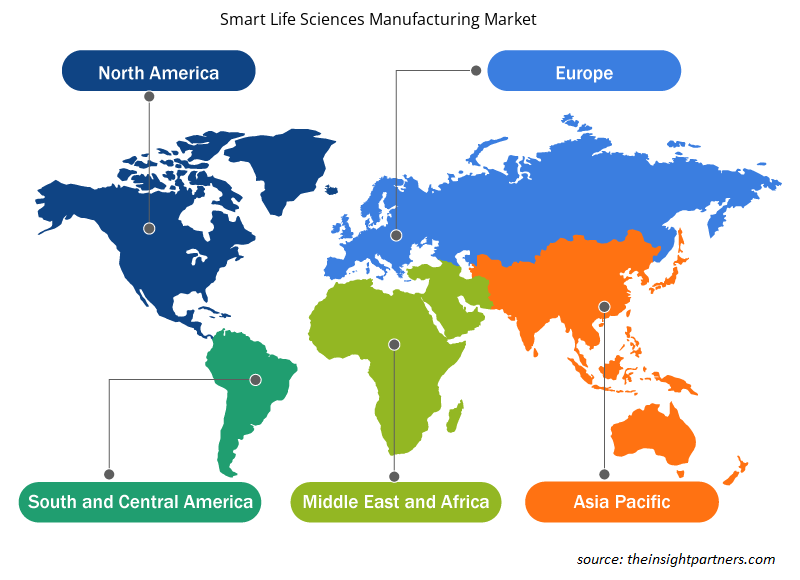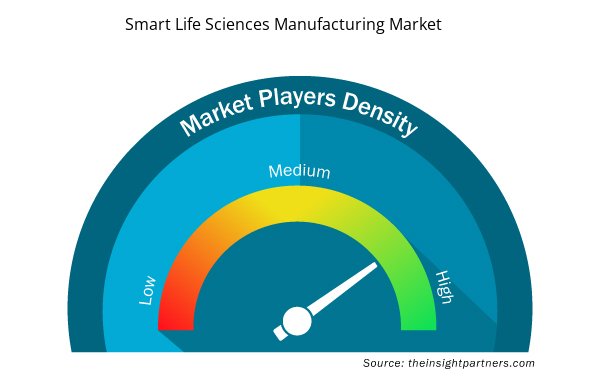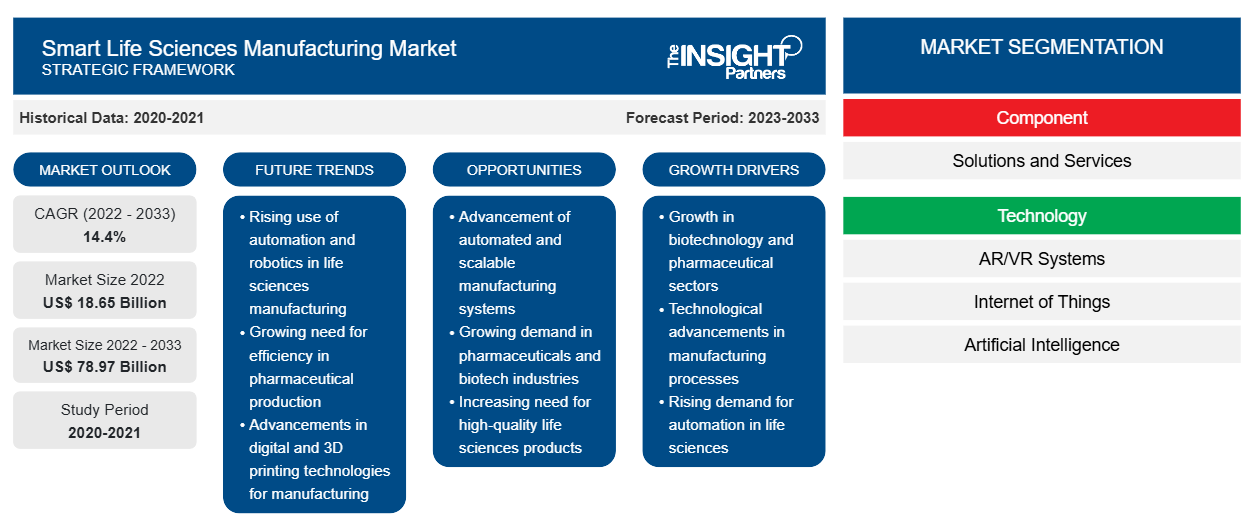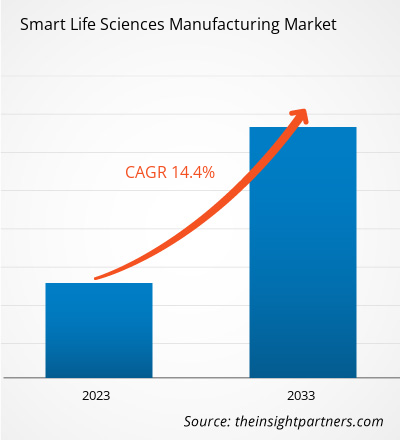智能生命科学制造市场预计将从 2022 年的 186.495 亿美元增至 2033 年的 789.7461 亿美元;预计 2023-2033 年期间的复合年增长率为 14.4%。
过去十年来,生命科学制造过程发生了巨大变化。生命科学制造是一个复杂的过程。将生产现场的机器和系统连接起来的智能工厂概念可以简化制造过程。该系统还连接到客户、合作伙伴和生产现场。在 COVID-19 大流行之后,许多制药和医疗器械制造商开始采用制药 4.0,尤其是由于法规和检查问题不断增加。智能生命科学制造(通常称为制药 4.0)旨在提供实用指导、嵌入监管最佳实践并加速制药 4.0 转型。主要目标是让参与制药产品生命周期的组织能够控制数字化的全部潜力,并为最终用户提供更快的治疗创新和改进的生产流程。这些变化将在未来几年为生命科学制造商带来巨大的机遇。现代数据分析工具使生物技术研究人员能够创建预测分析模型并了解实现其目标和目的的最有效方法。大数据、人工智能、虚拟现实、数据可视化和数据安全是生物技术实验室常用的技术。预计这些因素将在未来几年强力推动智能生命科学制造市场规模。
智能生命科学制造市场 -
定制此报告以满足您的需求
您可以免费定制任何报告,包括本报告的部分内容、国家级分析、Excel 数据包,以及为初创企业和大学提供优惠和折扣
- 获取此报告的关键市场趋势。这个免费样品将包括数据分析,从市场趋势到估计和预测。
市场洞察 – 智能生命科学制造市场
制药行业是全球工业部门的主要贡献者。此外,药品的需求和销售每天都在增加。因此,制药企业在研发方面投入了大量的经济资源,以将创新推向市场。技术升级是解决未来制造问题的关键。因此,制药 4.0 市场正在全球范围内受到极大关注。2022 年 6 月,英国制药巨头葛兰素史克在英国巴纳德城堡开设了新的无菌智能制造工厂。这家全自动工厂利用数字化来简化制造流程。这反过来又将使葛兰素史克能够加速新药的上市,同时减少浪费。2020 年 12 月,拜耳公司宣布在其制药部门内推出细胞和基因治疗平台。该平台将结合多种骨干功能,为细胞和基因疗法研发的整个价值链提供支持。2020 年 11 月,英国开始建造“未来工厂”,以改造小分子药物的生产。制药商、学术机构、医疗保健提供商和监管机构预计将齐聚该工厂,测试和改进新技术,包括连续、数字化和自主制造。因此,数字化转型的日益普及预计将扩大智能生命科学制造市场的规模。
基于组件的洞察
智能生命科学制造市场按组成部分可分为解决方案和服务。尽管解决方案部门的增长率低于服务部门,但预计在预测期内将占据更大的智能生命科学制造市场份额。随着数字化为流程带来灵活性和效率,制药行业正在迅速采用数字化转型。随着生产系统和流程的日益复杂,建立互联互通并根据良好生产规范 (GMP) 部署强大的智能工厂解决方案已成为生命科学公司的战略重点。此外,工业 4.0 简化了访问运营数据的流程,同时使企业能够满足目标关键绩效指标 (KPI)。智能制造解决方案通过监控库存的温度和湿度、监控端到端流程可见性、提高产品一致性以及识别与批量生产相关的特定问题来协助质量管理。生命科学行业致力于开发新颖、有效、优质和精确的治疗方法。该行业的先驱者正在利用最新的技术进步来探索新的治疗领域和方法,以获得竞争优势。这些因素推动了解决方案部门的智能生命科学制造市场增长。
智能生命科学制造市场根据组件、技术和应用进行细分。根据组件,市场分为解决方案和服务。根据技术,智能生命科学制造市场细分为增强现实/虚拟现实 (AR/VR) 系统、物联网 (IoT)、人工智能 (AI)、网络安全、大数据等。物联网细分市场在 2022 年占据了智能生命科学制造市场的最大份额。根据应用,智能生命科学制造市场细分为制药、生物制药和医疗设备。根据地理位置,智能生命科学制造市场主要细分为北美、欧洲、亚太地区 (APAC)、中东和非洲 (MEA) 和南美 (SAM)。ABB Ltd、博世力士乐股份公司、艾默生电气公司、Fortinet Inc、通用电气公司、霍尼韦尔国际公司、IBM 公司、罗克韦尔自动化、西门子股份公司和 Sophos Group plc 是智能生命科学制造市场的主要参与者。
智能生命科学制造市场区域洞察
Insight Partners 的分析师已详细解释了预测期内影响智能生命科学制造市场的区域趋势和因素。本节还讨论了北美、欧洲、亚太地区、中东和非洲以及南美和中美洲的智能生命科学制造市场细分和地理位置。

- 获取智能生命科学制造市场的区域特定数据
智能生命科学制造市场报告范围
| 报告属性 | 细节 |
|---|---|
| 2022 年市场规模 | 186.5亿美元 |
| 2033 年市场规模 | 789.7亿美元 |
| 全球复合年增长率(2022 - 2033 年) | 14.4% |
| 史料 | 2020-2021 |
| 预测期 | 2023-2033 |
| 涵盖的领域 | 按组件
|
| 覆盖地区和国家 | 北美
|
| 市场领导者和主要公司简介 |
|
智能生命科学制造市场参与者密度:了解其对业务动态的影响
智能生命科学制造市场正在快速增长,这得益于终端用户需求的不断增长,而这些需求又源于消费者偏好的不断变化、技术进步以及对产品优势的认识不断提高等因素。随着需求的增加,企业正在扩大其产品范围,进行创新以满足消费者的需求,并利用新兴趋势,从而进一步推动市场增长。
市场参与者密度是指在特定市场或行业内运营的企业或公司的分布情况。它表明在给定市场空间中,相对于其规模或总市场价值,有多少竞争对手(市场参与者)存在。
在智能生命科学制造市场运营的主要公司有:
- ABB有限公司
- 博世力士乐公司
- 艾默生电气公司
- Fortinet公司
- 通用电气公司
免责声明:上面列出的公司没有按照任何特定顺序排列。

- 了解智能生命科学制造市场顶级关键参与者概况
智能生命科学制造市场参与者主要注重合作伙伴关系来创造客户价值。
- 2023 年 2 月,专注于推进下一代癌症和罕见病治疗的细胞疗法 CDMO Theragent 与 Insight68 签署了一份为期多年的独家合同,Insight68 是一家人工智能驱动的软件提供商,旨在数字化和简化细胞疗法制造流程。此次合作加强了 Theragent 对 100% 数字化批次记录合规性的承诺,并提升了该公司作为当前生物制药制造转型中领先 CDMO 的声誉。
- 2022 年 12 月,Hovione 宣布与 GEA 就先进连续制片技术开展战略合作。Hovione 是一家致力于新兴制药技术工业化和大众化的公司。该公司提供无定形固体喷雾干燥分散体,可转化为可靠且可扩展的产品,供所有人使用。
- 历史分析(2 年)、基准年、预测(7 年)及复合年增长率
- PEST 和 SWOT 分析
- 市场规模价值/数量 - 全球、区域、国家
- 行业和竞争格局
- Excel 数据集


- Identity Verification Market
- Analog-to-Digital Converter Market
- Integrated Platform Management System Market
- Bioremediation Technology and Services Market
- Nuclear Waste Management System Market
- Cling Films Market
- Hydrolyzed Collagen Market
- Aircraft Landing Gear Market
- Surety Market
- Social Employee Recognition System Market

Report Coverage
Revenue forecast, Company Analysis, Industry landscape, Growth factors, and Trends

Segment Covered
This text is related
to segments covered.

Regional Scope
North America, Europe, Asia Pacific, Middle East & Africa, South & Central America

Country Scope
This text is related
to country scope.
常见问题
The incremental growth, expected to be recorded for the smart life sciences manufacturing market during the forecast period, is US$ 58,475.08 million.
The solutions segment led the smart life sciences manufacturing market with a significant share in 2022.
The smart life sciences manufacturing market is expected to reach US$ 78.974.61 million by 2033.
India, China, and Germany are expected to register high growth rates during the forecast period.
The US held the largest market share in 2022, followed by China.
Asia Pacific is the fastest growing regional market, followed by Europe.
The key players, holding majority shares, in smart life sciences manufacturing market includes ABB Ltd, Emerson Electric Co, General Electric Co, Honeywell International Inc, and Rockwell Automation.
The connection of data silos is increasing, which is likely to result in better access to insights and data leads. Additionally, there is an increasing usage of blockchain, coupled with roadmaps been created for Pharma 5.0.
Smart life sciences manufacturing market is being driven by the growing adoption of Pharma 4.0. Additionally, rising application of advanced technologies in cancer research is expected to provide growth opportunities for the smart life sciences manufacturing market.
The global smart life sciences manufacturing market was estimated to be US$ 18,649.50 million in 2022 and is expected to grow at a CAGR of 14.4%, during the forecast period 2023 - 2033.
Trends and growth analysis reports related to Technology, Media and Telecommunications : READ MORE..
The List of Companies - Smart Life Sciences Market
- ABB Ltd
- Bosch Rexroth AG
- Emerson Electric Co
- Fortinet Inc
- General Electric Co
- Honeywell International Inc
- IBM Corporation
- Rockwell Automation
- Siemens AG
- Sophos Group plc
The Insight Partners performs research in 4 major stages: Data Collection & Secondary Research, Primary Research, Data Analysis and Data Triangulation & Final Review.
- Data Collection and Secondary Research:
As a market research and consulting firm operating from a decade, we have published and advised several client across the globe. First step for any study will start with an assessment of currently available data and insights from existing reports. Further, historical and current market information is collected from Investor Presentations, Annual Reports, SEC Filings, etc., and other information related to company’s performance and market positioning are gathered from Paid Databases (Factiva, Hoovers, and Reuters) and various other publications available in public domain.
Several associations trade associates, technical forums, institutes, societies and organization are accessed to gain technical as well as market related insights through their publications such as research papers, blogs and press releases related to the studies are referred to get cues about the market. Further, white papers, journals, magazines, and other news articles published in last 3 years are scrutinized and analyzed to understand the current market trends.
- Primary Research:
The primarily interview analysis comprise of data obtained from industry participants interview and answers to survey questions gathered by in-house primary team.
For primary research, interviews are conducted with industry experts/CEOs/Marketing Managers/VPs/Subject Matter Experts from both demand and supply side to get a 360-degree view of the market. The primary team conducts several interviews based on the complexity of the markets to understand the various market trends and dynamics which makes research more credible and precise.
A typical research interview fulfils the following functions:
- Provides first-hand information on the market size, market trends, growth trends, competitive landscape, and outlook
- Validates and strengthens in-house secondary research findings
- Develops the analysis team’s expertise and market understanding
Primary research involves email interactions and telephone interviews for each market, category, segment, and sub-segment across geographies. The participants who typically take part in such a process include, but are not limited to:
- Industry participants: VPs, business development managers, market intelligence managers and national sales managers
- Outside experts: Valuation experts, research analysts and key opinion leaders specializing in the electronics and semiconductor industry.
Below is the breakup of our primary respondents by company, designation, and region:

Once we receive the confirmation from primary research sources or primary respondents, we finalize the base year market estimation and forecast the data as per the macroeconomic and microeconomic factors assessed during data collection.
- Data Analysis:
Once data is validated through both secondary as well as primary respondents, we finalize the market estimations by hypothesis formulation and factor analysis at regional and country level.
- Macro-Economic Factor Analysis:
We analyse macroeconomic indicators such the gross domestic product (GDP), increase in the demand for goods and services across industries, technological advancement, regional economic growth, governmental policies, the influence of COVID-19, PEST analysis, and other aspects. This analysis aids in setting benchmarks for various nations/regions and approximating market splits. Additionally, the general trend of the aforementioned components aid in determining the market's development possibilities.
- Country Level Data:
Various factors that are especially aligned to the country are taken into account to determine the market size for a certain area and country, including the presence of vendors, such as headquarters and offices, the country's GDP, demand patterns, and industry growth. To comprehend the market dynamics for the nation, a number of growth variables, inhibitors, application areas, and current market trends are researched. The aforementioned elements aid in determining the country's overall market's growth potential.
- Company Profile:
The “Table of Contents” is formulated by listing and analyzing more than 25 - 30 companies operating in the market ecosystem across geographies. However, we profile only 10 companies as a standard practice in our syndicate reports. These 10 companies comprise leading, emerging, and regional players. Nonetheless, our analysis is not restricted to the 10 listed companies, we also analyze other companies present in the market to develop a holistic view and understand the prevailing trends. The “Company Profiles” section in the report covers key facts, business description, products & services, financial information, SWOT analysis, and key developments. The financial information presented is extracted from the annual reports and official documents of the publicly listed companies. Upon collecting the information for the sections of respective companies, we verify them via various primary sources and then compile the data in respective company profiles. The company level information helps us in deriving the base number as well as in forecasting the market size.
- Developing Base Number:
Aggregation of sales statistics (2020-2022) and macro-economic factor, and other secondary and primary research insights are utilized to arrive at base number and related market shares for 2022. The data gaps are identified in this step and relevant market data is analyzed, collected from paid primary interviews or databases. On finalizing the base year market size, forecasts are developed on the basis of macro-economic, industry and market growth factors and company level analysis.
- Data Triangulation and Final Review:
The market findings and base year market size calculations are validated from supply as well as demand side. Demand side validations are based on macro-economic factor analysis and benchmarks for respective regions and countries. In case of supply side validations, revenues of major companies are estimated (in case not available) based on industry benchmark, approximate number of employees, product portfolio, and primary interviews revenues are gathered. Further revenue from target product/service segment is assessed to avoid overshooting of market statistics. In case of heavy deviations between supply and demand side values, all thes steps are repeated to achieve synchronization.
We follow an iterative model, wherein we share our research findings with Subject Matter Experts (SME’s) and Key Opinion Leaders (KOLs) until consensus view of the market is not formulated – this model negates any drastic deviation in the opinions of experts. Only validated and universally acceptable research findings are quoted in our reports.
We have important check points that we use to validate our research findings – which we call – data triangulation, where we validate the information, we generate from secondary sources with primary interviews and then we re-validate with our internal data bases and Subject matter experts. This comprehensive model enables us to deliver high quality, reliable data in shortest possible time.


 获取此报告的免费样本
获取此报告的免费样本